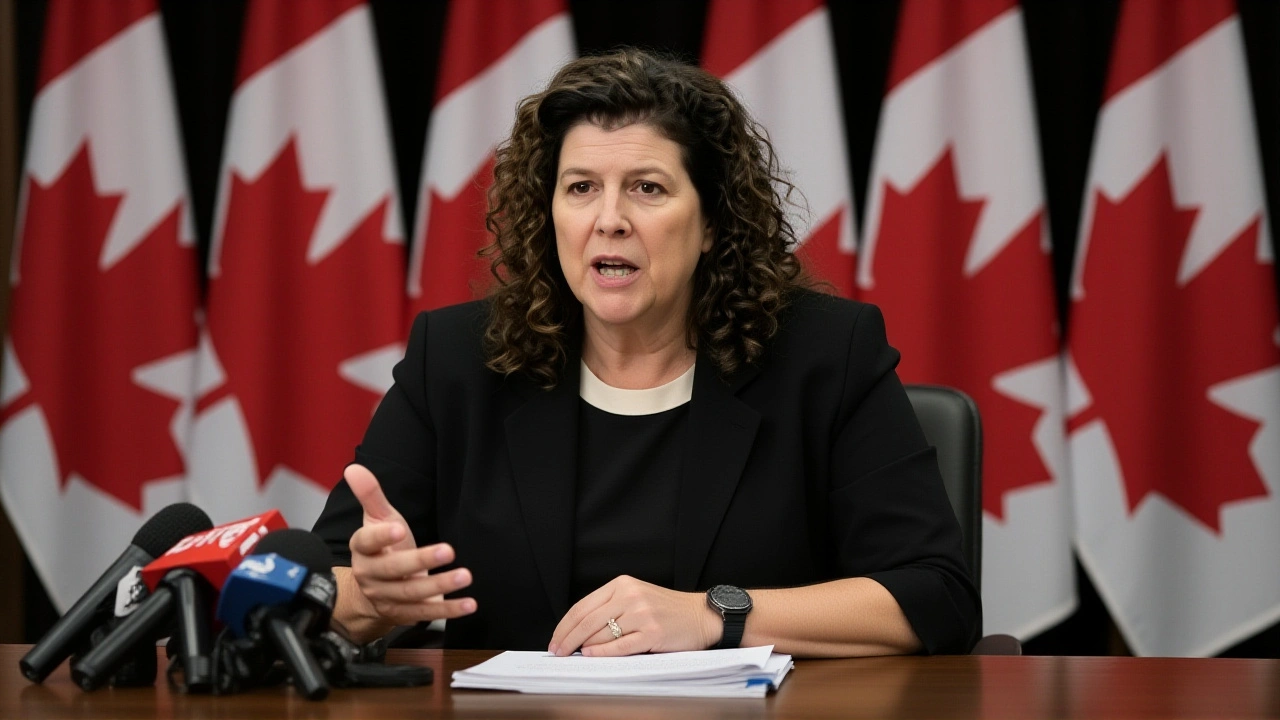When Karen Hogan, Auditor General of Canada of the Office of the Auditor General released her June 10, 2025 performance audit, the headline was stark: just 2 % of the federal real‑estate footprint had been right‑sized, even though about half of government offices sit empty or underused.
The audit, part of Report 3 in a series of four reports to Parliament, zeroed in on Public Services and Procurement Canada (PSPC). From 2019 to the end of 2024, PSPC trimmed less than 2 % of its office space, far short of the bold 50 % cut promised when hybrid work became the norm after the pandemic.
Why the audit matters now
Here’s the thing: vacant cubicles and idle buildings cost taxpayers millions every year in utilities, maintenance, and security. Hogan’s office warned that the lack of a clear inventory means the government is essentially flying blind, unable to decide which properties to keep, sell, or repurpose.
"We are seeing a massive mismatch between the space the government holds and the space it actually needs," Hogan said in the report. "If managed properly, surplus properties could be sold or transformed into affordable housing, delivering tangible benefits to low‑income families across Canada."
Historical backdrop: From pandemic to present
When COVID‑19 shut down offices in 2020, federal departments rushed to adopt hybrid models. The expectation was simple: keep only what you need for a three‑day‑a‑week schedule, get rid of the rest. Instead, bureaucracy stalled. By 2022, internal memos showed PSPC grappling with outdated data systems, and by 2024, half of the nation’s federal workspaces were still officially "occupied" on paper.
Ottawa, the capital, saw the bulk of the inertia. Ottawa houses roughly 1,200 federal offices, many of which have been empty for years. Yet the government’s asset registry still lists them as fully utilized, a discrepancy that the audit highlighted in bright red.
Key findings from the auditor’s lens
- Only 2 % of the targeted office‑space reduction achieved between 2019‑2024.
- Approximately 48 % of federal offices are underused or vacant.
- PSPC lacks a centralized, real‑time database to track occupancy.
- Maintenance costs for surplus buildings have risen by an estimated $120 million annually.
- Potential revenue from selling or converting surplus properties exceeds $2 billion over the next decade.
Government response
Minister Marco Lightbound, Minister of Public Services and Procurement of Public Services and Procurement Canada issued a statement on June 10, acknowledging the "significant delays" in meeting the 50 % reduction goal. "We are taking the auditor’s recommendations seriously and will accelerate our data‑collection efforts," Lightbound said, adding that a new cross‑departmental task force will be launched by the end of the year.
But wait – the audit also flagged that PSPC’s own disposal plan doesn’t factor in the extra operating costs of keeping surplus buildings around. In other words, the government may be paying to keep buildings that it never intends to sell.
Recommendations and their ripple effects
The auditor laid out six concrete steps, the most visible being an annual public report on office‑space usage, occupancy density, and progress toward the 50 % target. If PSPC publishes those numbers, journalists, analysts, and even the public could hold the department accountable in real time.
Another recommendation: collaborate with central agencies and federal tenants to negotiate smaller footprints. Imagine a department that now occupies a 20‑story tower agreeing to move into a 10‑story building, freeing up a whole floor for conversion into affordable units. That could directly boost housing supply in high‑cost markets like Toronto and Vancouver.
Turns out, the potential savings aren’t just fiscal. The twist is that many surplus sites sit on prime downtown land. Converting them into sustainable, accessible housing could address two policy goals at once – fiscal prudence and the chronic housing shortage.
Looking ahead: What to watch for
First, the next quarterly progress report—due by the end of 2025—will reveal whether PSPC can break the 2 % barrier. Second, watch for any legislative motions in Parliament calling for tighter oversight of federal real‑estate assets. Finally, keep an eye on local municipalities; if surplus properties are sold, they’ll likely be earmarked for community projects, which could reshape neighbourhoods across the country.
In short, the audit isn’t just a slap on the wrist; it’s a roadmap for how Canada could reclaim billions of dollars and turn empty hallways into homes for families who need them most.
Frequently Asked Questions
How does the 2% reduction affect Canadian taxpayers?
With only a 2 % cut, the government continues to spend roughly $120 million a year on heating, electricity, and maintenance for empty offices. Those costs flow directly into the federal budget, meaning less money available for services like health care or education.
What is the government’s target for office‑space reduction?
The original policy, announced in 2019, called for a 50 % reduction in the federal office‑space portfolio by 2025. The auditor’s report shows the government is miles away from that goal.
Why is accurate data on vacant offices important?
Without a reliable inventory, departments can’t identify which properties are truly excess. That hinders disposal, prevents potential revenue, and blocks the conversion of surplus land into affordable housing, a critical need in many Canadian cities.
What could happen to surplus federal properties?
The auditor suggests they could be sold to private developers, transferred to provincial or municipal governments, or directly repurposed into sustainable, low‑income housing projects. Each option would generate revenue and address housing shortages.
When will the next progress report be released?
Under the auditor’s recommendations, Public Services and Procurement Canada must publish an annual update. The first of these is expected by December 2025, covering the fiscal year 2024‑2025.







Balaji Srinivasan
Looks like the government’s office‑space plan is stuck in slow motion.
Anurag Narayan Rai
The audit really pulls back the curtain on a decade‑long drift where ambition met inertia, and the numbers tell a story that’s hard to ignore. From 2019 to 2024 the targeted 50 % cut never even got past the starting line, leaving a mere 2 % dent that sounds almost like a typo. When you consider that almost half of federal offices sit empty, the wasted utilities alone start to look like an absurd budget line item. Those empty cubicles are not just idle desks; they are heating, electricity, and security costs that silently bleed taxpayer dollars. The lack of a real‑time occupancy database means policymakers are effectively flying blind, trying to steer a ship without a compass. Imagine if every vacant floor could be turned into affordable housing – that would be a two‑for‑one win: reducing costs and addressing a chronic shortage. The auditor’s recommendation for an annual public report could serve as a reality check, forcing the department to actually count the empty rooms instead of glossing over them. A transparent ledger would let journalists and citizens spot where the money is being wasted and where it could be recouped. The projected $2 billion potential revenue isn’t just a number; it could fund schools, healthcare, or even more housing projects. Yet the current disposal plan seems blind to the ongoing operating costs of holding onto these surplus buildings, which adds another layer of inefficiency. If PSPC can’t even get its inventory straight, how can it negotiate deals with developers or local municipalities? The federal‑provincial partnership potential is huge – selling a downtown building to a city for a community centre could reshape neighborhoods. On the other hand, the bureaucratic inertia that kept the office‑space numbers stagnant also reflects a deeper cultural resistance to change within the public service. Without a cultural shift, any technical solution will likely be patched over with more paperwork. The upcoming quarterly progress report will be a litmus test: will we see a jump from 2 % to something meaningful, or will the same story repeat? In short, the audit is more than a slap on the wrist; it’s a blueprint for reclaiming billions and turning empty hallways into homes for families who need them.
Maneesh Rajput Thakur
Honestly, the whole thing feels like a classic case of government saying one thing and doing another, and the audit just shines a spotlight on that disconnect. I’m not saying there’s a grand conspiracy, but the data gaps are pretty glaring.
Himanshu Sanduja
It’s frustrating to see half of the offices just sitting there while Canadians struggle with housing costs. If we could repurpose even a fraction of those spaces, it could make a real difference.
Kiran Singh
Totally agree – a public dashboard would keep everyone honest and maybe even spark some community ideas.
deepika balodi
The audit’s numbers are clear: we need smarter data and faster action.
Priya Patil
Could the surplus buildings be turned into co‑working spaces for startups? That might be a win‑win.
Rashi Jaiswal
Imagine the impact if those empty floors become affordable housing 🏠💡. We’d finally see some real progress!
Shubham Abhang
It’s hard not to wonder who’s benefiting from keeping so many buildings idle-there’s got to be more to this story.
Trupti Jain
While the audit lays out the financial bleed, the cultural inertia behind bureaucratic red tape seems to be the true villain.
Vibhor Jain
Sure, let’s keep paying for empty rooms while the rest of the country waits for a miracle.